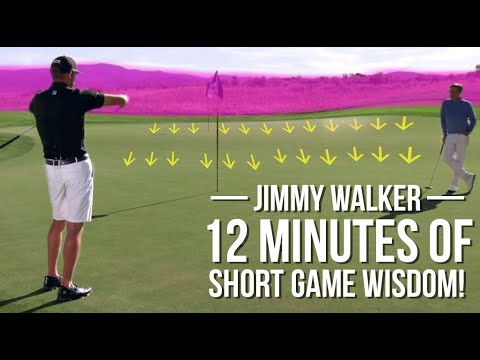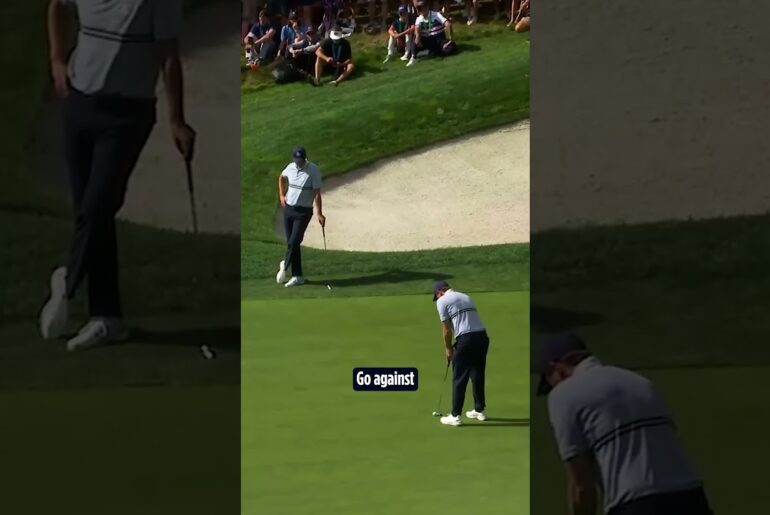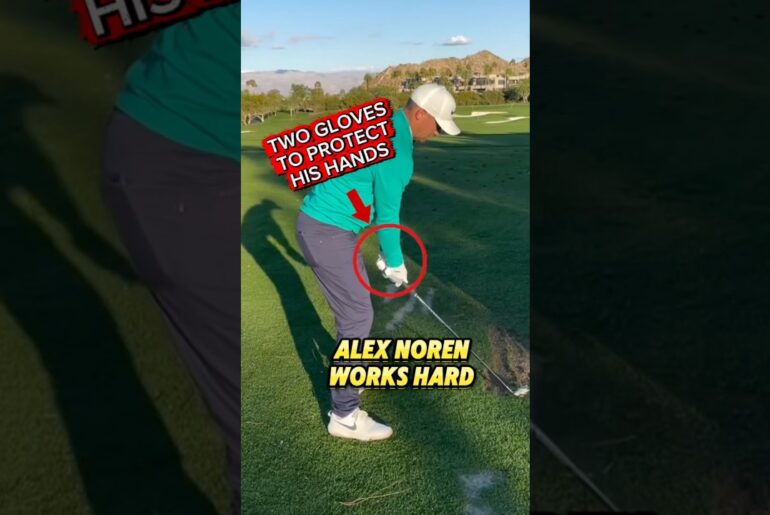Jimmy Walker shares his approach on the short game and putting and give tips on how amateurs can start getting their short game shots closer to the hole and drills to start making more putts.
There you go. What’s the best putting tip you’ve ever gotten? Maybe the best one ever. I think stuff sticks with you when you’re a kid. I played a lot of golf with David Ogen growing up. Yeah. And he was a San Antonio guy and me and him, my dad played a lot and he watched me hit a putt one day from real close. It was three foot or something and I lagged on up there and walked up and set up and didn’t even take my time and missed it. He’s like, “Don’t ever hit a putt without 100% intent.” And he kind of shamed me into it a little bit. Like, why are you doing that? If you’re going to putt it, make it. Putt with intent in every single one of them. It’s his short game with Jimmy Walker right now on Golf Channel Academy. We’re at Victory Ranch, which is one of your homes. This is sensory overload. So, you really do have to focus when you’re out here. You You mentioned trying to keep it simple. When you’re wrapping putts, what are the things that are the most important things that you start with when it comes to making putts? As I approach this green, as I’m walking up into into the green at a tournament or just any golf course, I’m already looking at what’s going on. We’ve got this kind of stadium backdrop here. So, I I can see that everything is working this way. We’ve got a big hump in the middle, like a like a ridge in the middle of the screen that sections the green. We’ve got bunkers that come off this side. So, usually you’re going to have slope coming back in this way. So, those are all things that I’m starting to really kind of look at. As I’m walking up, I can see different shines on the green. You know, this back left section back here, there’s more shine this way. So, I can tell that even though it’s uphill, that grain is kind of trying to work its way back up here. And then in this back section, it’s it’s dark. So, it’s all all the grain’s working back this way. So, those are all things that you’re starting to look at as you walk into a green, or you should be anyways. Sure. Now, you’ve determined the read of this. This is slightly going uphill. Your process. Slightly going uphill. I think it’s, you know, looking at it, I think it’s going to break just a little bit to the left. I’m going to put it just outside kind of the the edge of the hole. So, I what I do is I get my line in there where I like it. I’ll check it real quick. See if it feels and looks good. It does. I’ll get back and take one more look at it. Come in and just kind of visualize the stroke I need to take to hit the putt. Usually two or three, which is kind of a feel thing. Then we get in there and try not to waste too much motion. Speed was off or made it. Well, just a bit. Now, when we look at swing 360 face on technically, what is the viewer seeing with you? You know, from a face on angle, I like to get it just slightly up of center. And I’d like to have a a kind of a more stacked look to it. Just the with the shaft just leaning forward just a little bit. I don’t want it too far back and I don’t want it too far forward. Feet just comfortable. I don’t I’m not here. I’m not here. You know, just just something nice and comfortable where I feel stable and elbows kind of locked in. So a nice kind of stack look this way. Backstroke is going to be longer than the follow through. The follow through stays shorter. Mhm. So on a face on, you know, that’s kind of what you’re going to see. Okay. How about down the line? Down the line, hopefully everything is kind of squared up. You’ll see the putter sitting flat shaft and arms, forearms are kind of in alignment. And then you’ll see kind of a lower inside to square stroke and then kind of holding that finish out there down the line. So my stroke has always been a little inside with an arc and then coming back down the line. As you step into this putt, take us through what is or isn’t going through your mind. What isn’t going through my mind is I hope I make this. If you’re not thinking positive, doesn’t matter if you’re putting or hitting a shot. I mean, you’re pretty toast. So, okay, you know, putt like this, we get in there and like, okay, I’m gonna make this sucker. and you get up on that right edge and get everything together and give it a nice little wrap. That one didn’t break, but you know, it it got past the hole. Yeah. Well, the selft talk, nobody made more putts, more birdies than he did in 2014. And he’s going, I wonder how much I made. Well, he’s going to find out if he doesn’t already know right after this. All right, lag putting. Everybody has a different approach. It doesn’t mean one is right or one is wrong. What is yours? Same principles apply. Finding a good line. I think pace is more important on a on a lag putt cuz you know if your if your pace is good, you’re not going to be that far away from the hole. If you’re if you miss it four feet to the right, but your pace is good, you got a 4-footer. If you’re four feet right and you hit it five feet too far, you got a long putt. So pace is everything on a long putt. Same thing. Get in there. Get you a good feel. Couple of practice strokes. Kind of looking at it. Really take a good look at it because man, I got to I got to get this close. Same thing. You mentioned pace. I mean, that that’s four four and a half ft by. When you have a putt in excess of 30 feet. Just give people context. If you lead the PJ tour in proximity, you’re about 30 to 32 ft. So on average, this is the putt you have for birdie on every hole. I think anything inside of 3 ft outside of, you know, 30 feet, 40 ft is 100% acceptable. Okay? You know, and that’s if you’re within that 3-ft zone, you got a chance to make it. Jimmy, you’ve got this alignment rod here and you’re going, “What what is that doing on the putting green?” you incorporate that with something that you think is really important to you being a good putter. What is it? I use the alignment stick for purely for stroke. So, what I’ll do for practice a lot, especially before a round, is I’ll come in here and I’ll try to find a I’ll find the a real straight putt, something that’s super simple, and I’ll get that I’ll get that stick out there. And it might take just a little bit of tweaking, but I’ll get that right there. And what I like to do is get the ball set up here. I’ll get everything set up. And when I come back, I can see that my putter has arked back onto that line. And then when I finish, it’s usually going to be close to it, if not more, just kind of straight down towards the hole. And so all I end up doing here is I just practice. It’s just stroke. Okay. So, and you use a three ball game. Explain what you’re doing. So, we’ve been kind of doing a three ball drill where I’ll take three balls from between like nine and 15 feet and I’ll stagger them about like that. So, then what I’m doing is I’ll I’ll read each putt and I’ll come in and it takes a little bit of time, but you’re trying to make all these putts. So, I’ll get it lined up where I think and I’ll come in and you get to do you get 18 putts and you putt them and you So, you go through all three balls and you’re trying to make at least eight out of 18. Okay, that means you’re making a pretty good amount of putts for the percentages from those distances. though just slightly less than 50% which again if you look at stats from that distance you’re you’re going to be at the top of the PGA Tour when it comes to if you’re making 8 to 15 footers roughly 40 to 45% of the time that’s pretty good. Yeah. So that’s that’s just kind of the goal and go do that a few times and so that’s the goal is to make these putts because those are the ones that vault you up the leaderboard. Okay. What’s your record in this game? 18 balls. How many? 10 is it? And you move around. You don’t just putt the same putt every time. You move to different holes and you’ve got to do different reads and you give yourself uphill, downhill, left to riders, you know, harder putts. And usually it was it’s my caddy that’s throwing them down. So, he’s making it hard. And I mean, he’s not just giving me the cherry picker putts, you know, so it’s he’s making it tough. All right. Well, it’s not just around the green. It’s also when you miss a green down in the bunker. That’s coming up. You know, Jimmy, a shot like that for someone at your level, not a lot of stress there, but for a lot of people, chipping, execution, the the simple things for you, what are they? I think for a lot of people in the beginning, keep it real simple. Putting motion, let the loft do the work for you. And then as you start progressing, then you can start playing with your hands a little more, using the balance of the club more, hitting different types of shots, you know, higher shots, lower shots. But in the beginning, I think for simple, you know, shots like this, just keeping it simple for people, for you, your execution, your landing spot for a shot like this, where are you looking at? So, I mean, from this from this distance right here, I’ve got about the same amount of fairway and green. So, I’m thinking the ball needs to fly with this trajectory about a foot onto the green and it’s going to have a nice roll. Like, I’m not hitting it hard enough to put any kind of crazy amount of spin on it. It’s just kind of letting it get up onto the green and it just kind of rolls out. So, that’s where you’re when you practice knowing how much speed you’re putting on the ball and how much spin it’s creating. And then there’s so many factors of how soft is the green, is it firm, and trying to figure all that out? Uh some weeks you’ve got it really good, some you don’t. Now, for swing 360, what are people seeing face on in terms of how you’re using that club? Well, for a low shot, I think what people are going to see face on is they’re going to notice the ball is going to be played more off my my back right foot, and I’m going to put a lot more forward press on it. with all this keeps that shot coming out lower. We’ll have a nice little check on it. Nothing crazy. I think down the line it’s it’s more the same. I don’t think you’re going to be able to see more ball position or anything, but I think you might be able to see more of the path. So, again, ball more in the back. Club face pretty square. Body feels pretty square. Feet a little open that they might be able to see that. And then just more kind of around the body. Now, how about a stock shot that’s going to be a little bit higher. Ball’s going to be a little more up in the stance. I think club face will be open a little bit. And I think the hands are going to be more neutral right in the center. Maybe even hands back just a little bit. And then just kind of same thing, a little more hands to have some loft. And it comes off higher, more spin. Just like that. Okay. Now, how about to that back pin up on that shelf? You gonna take that a little bit higher? No, I don’t think so. I think this is one that we’ve got this long run up and then a shelf and then it it crests and the pin’s just it’s right there. So, uh I don’t think flying this all the way there is a good option because there’s no room to really play with that and I don’t I think your margin of error of trying to fly it into that face and having it stop, it’s just a tougher shot. So, this is going to be kind of more one of those longer runners where I’ll put it more in the back. Club face real square, hands in front, kind of get down there, just kind of swing it more around the body. Just get her to kind of run up that hill a little bit. Like I said, you don’t have to use a 60, but man, that’s how I grew up playing and practicing and pitching. And that’s probably the harder way to do it, but that’s how I did it. you know, taking an eight iron out and getting it to run. I can do it, but this is what I feel comfort doing. Well, clearly you do. We’re just outside of Park City, Utah. His happy place, Victory Ranch. Thanks for having us, Jimmy. to the pleasure.








1 Comment
👍👏💯